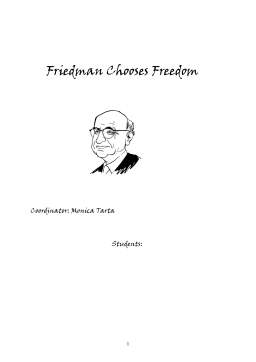Extras din proiect
1. Monetarism – A Reaction to Keynesianism
Monetarism emerged in 1968 as a strong reaction to the Keynesianism theory. However, it was already formulated 1956, but became a force in the late 1960s. It is more liberal and focuses on the macroeconomic consequences of the supply of money and of the central banking. What it proposes is that excessive expansion of the money supply is innately inflationary and that the monetary authorities should focus primarily on maintaining price stability.
2. Milton Friedman - An Influential Monetarist
During his career, Friedman made a number of enduring contributions to the domain of economics. He became an articulate spokesman for free markets and free societies in an era when many social scientists disparaged market solutions to social problems. Friedman's collaborative work with Anna J. Schwartz has remained a vital resource for those interested in the monetary history of the United States. Other legacies include Friedman's revival of a monetary approach to macroeconomics and his persistent critique of the Keynesian orthodoxy of his day.
The forefront person of Monetarism, Friedman formulated this doctrine on the basis of Keynes’ own words. As opposed to Keynes (who enlarged upon the value stability of currency which being insufficient led to alternate currency and even collapse), Friedman said there should be equilibrium between supply and demand for money.
This doctrine relates to several concepts and ideas which will be depicted below.
2.1. Quantity Theory of Money
Quantity theory of money was developed in 1885 by the Americans Simon Newcomb (1835-1909) and Irving Fisher (1867-1947), the latter of whom's original equation stated in simple terms that the amount of money in circulation equals money national income; that is, MV = PT where M is money stock, V is velocity of circulation, P is average price level and T the number of transactions. The equation assumes that the velocity of circulation of money is stable (at least in the short term) and that transactions are fixed by consumer tastes and the behavior of firms.
Quantity theory of money was superseded by Keynesian analysis. Members of the Cambridge School were concerned with the volume of money held given the number of transactions carried out. They argued that the greater the number of transactions, the greater the amount of money held. They replaced PT by Y (the income velocity of circulation). The equation is: V = Y / M where M is money stock in economy, Y income velocity of circulation and V average velocity of circulation.
Friedman resurrected the Quantity Theory of Money even though he was accused he formulated his doctrine in Keynes’s own words. This confusion was not assisted by Friedman's recurrent use of the terminology of the Quantity Theory of Money to expound his theory. Irving Fisher's (1911) famous "equation of exchange" states that: MV = PY, where M is the money supply, V is velocity, P the price level and Y the real output level. The term on the right (PY) is therefore nominal income or nominal output. We can rewrite this as M/P = (1/V) Y, which effectively states that real money supply (M/P), is equal to real money demand (1/V) Y. This equation represents the money Markey equilibrium condition.
For the Quantity Theory, the following series of assumptions are then imposed: firstly, nominal money supply M is assumed to be exogenous and thus subject to the full control of the Central Bank; secondly, velocity V is assumed constant; thirdly, the aggregate nominal demand component is assumed to cause changes in nominal income, i.e. causality runs from MV to PY; fourthly, output Y is fixed at the full employment level. The final assumption of the direction of money-income causality was a central feature in Friedman's theory and became the curious point of dispute between Keynesians and Monetarists. In the MV=PT equation, money supply is considered to be an exogenous variable influenced by the Government and banks decisions. The velocity of money and the output are considered physical variables, which do not expect to change and are considered fixed, at least on the short term. Price is an endogenous variable and is the only one affected by a rise in the money supply. His theory says that, according with the Fisher’s equation stated above, an increase in the money supply leaves the real variables, output and employment unchanged, that is, has a neutral effect on them. Still, this increase in the money will spur only an increase in the nominal variable, the price. In other terms, it will lead to inflation.
The other way round relationship between prices and money supply is not causal. Monetarists argue that an increase in prices would not lead to inflation unless the government increased the money supply.
Preview document
Conținut arhivă zip
- Friedman Chooses Freedom.doc












